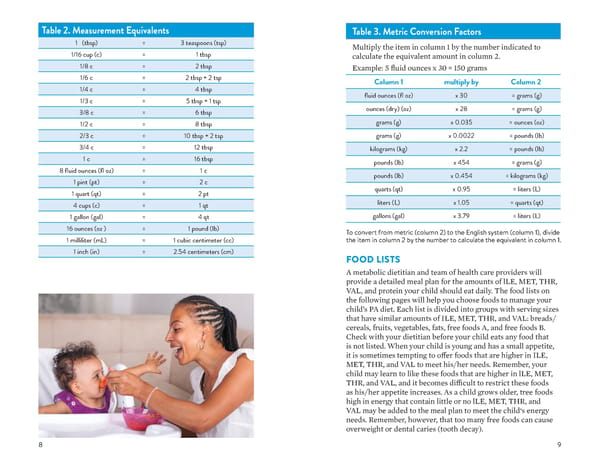Table 2. Measurement Equivalents Table 3. Metric Conversion Factors 1 (tbsp) = 3 teaspoons (tsp) Multiply the item in column 1 by the number indicated to 1/16 cup (c) = 1 tbsp calculate the equivalent amount in column 2. 1/8 c = 2 tbsp Example: 5 fluid ounces x 30 = 150 grams 1/6 c = 2 tbsp + 2 tsp Column 1 multiply by Column 2 1/4 c = 4 tbsp fluid ounces (fl oz) x 30 = grams (g) 1/3 c = 5 tbsp + 1 tsp 3/8 c = 6 tbsp ounces (dry) (oz) x 28 = grams (g) 1/2 c = 8 tbsp grams (g) x 0.035 = ounces (oz) 2/3 c = 10 tbsp + 2 tsp grams (g) x 0.0022 = pounds (lb) 3/4 c = 12 tbsp kilograms (kg) x 2.2 = pounds (lb) 1 c = 16 tbsp pounds (lb) x 454 = grams (g) 8 fluid ounces (fl oz) = 1 c pounds (lb) x 0.454 = kilograms (kg) 1 pint (pt) = 2 c quarts (qt) x 0.95 = liters (L) 1 quart (qt) = 2 pt 4 cups (c) = 1 qt liters (L) x 1.05 = quarts (qt) 1 gallon (gal) = 4 qt gallons (gal) x 3.79 = liters (L) 16 ounces (oz ) = 1 pound (lb) To convert from metric (column 2) to the English system (column 1), divide 1 milliliter (mL) = 1 cubic centimeter (cc) the item in column 2 by the number to calculate the equivalent in column 1. 1 inch (in) = 2.54 centimeters (cm) FOOD LISTS A metabolic dietitian and team of health care providers will provide a detailed meal plan for the amounts of lLE, MET, THR, VAL, and protein your child should eat daily. The food lists on the following pages will help you choose foods to manage your child’s PA diet. Each list is divided into groups with serving sizes that have similar amounts of ILE, MET, THR, and VAL: breads/ cereals, fruits, vegetables, fats, free foods A, and free foods B. Check with your dietitian before your child eats any food that is not listed. When your child is young and has a small appetite, it is sometimes tempting to offer foods that are higher in ILE, MET, THR, and VAL to meet his/her needs. Remember, your child may learn to like these foods that are higher in lLE, MET, THR, and VAL, and it becomes difÏcult to restrict these foods as his/her appetite increases. As a child grows older, tree foods high in energy that contain little or no lLE, MET, THR, and VAL may be added to the meal plan to meet the child‘s energy needs. Remember, however, that too many free foods can cause overweight or dental caries (tooth decay). 8 9
 A Food List for Propionic Acidemia (PA) Page 4 Page 6
A Food List for Propionic Acidemia (PA) Page 4 Page 6